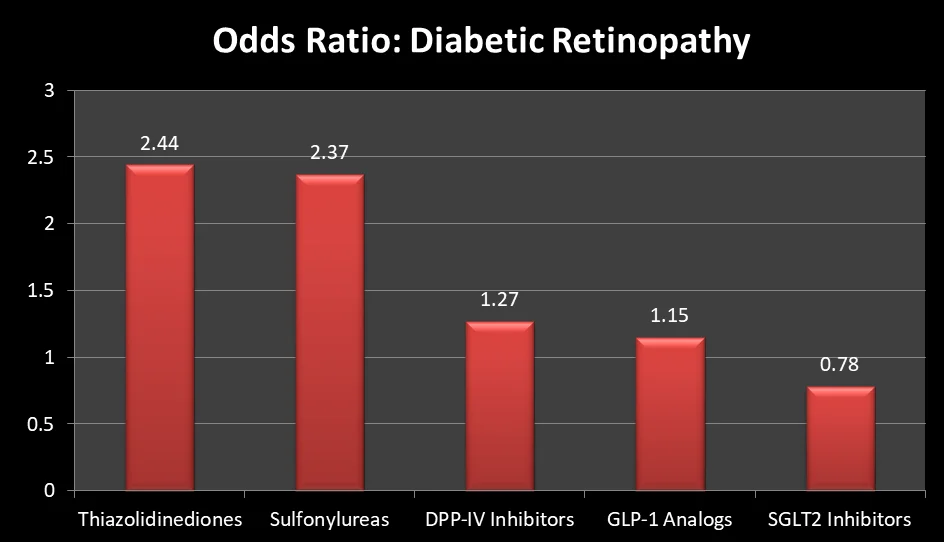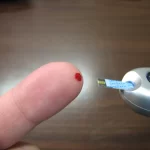Ozempic Retinopathy or Semaglutide Retinopathy is not a distinct form of eye disease.
Or maybe it is. Does Semaglutide affect the eye directly or is it the rapid glucose changes that result in the worsening of diabetic eye disease?
If the change in blood glucose is responsible for worsening diabetic retinopathy, then all potent diabetes medicines including insulin and Tirzepatide (Mounjaro) should have a similar or a much greater effect on the eyes.
What is Diabetic Retinopathy?
Diabetic retinopathy or diabetic eye disease is one of the most common complications of diabetes. In fact, it is the second most common complication of longstanding diabetes after diabetic neuropathy.
The initial glucose cut-offs to label a person as diabetic were based on the blood glucose readings that resulted in eye changes.
Like diabetes, diabetic retinopathy is a silent disease. People have symptoms only when the disease is advanced. In the early stages, it is totally asymptomatic and usually picked up on routine screening tests.
Diabetic retinopathy is commonly classified into two broad categories:
- Non-proliferative diabetic retinopathy, and
- Proliferative diabetic retinopathy
Diabetic patients with non-proliferative diabetic retinopathy have exudates, microaneurysms, and microhemorrhages in their retinas.
On the other hand, neovascularization is the hallmark of proliferative diabetic retinopathy.
The formation of new blood vessels in the retina along with changes seen in patients with non-proliferative diabetic retinopathy can be seen.
Neovascularization is the hallmark of diabetic retinopathy
In advanced proliferative diabetic retinopathy, macular edema, and fibrovascular tissue proliferation resulting in traction retinal detachment can be seen.
Optimal glucose control can prevent the progression of diabetic retinopathy. In the UKPDS, each 1% HbA1C improvement is associated with a 37% reduction in the risk of diabetic retinopathy.
1% reduction in HbA1C = 37% reduction in Diabetic Retinopathy
Hypertension, hyperlipidemia, and pregnancy are other risk factors for the progression of diabetic retinopathy.
Optimal blood pressure control and management of dyslipidemia are as important as diabetes.
Other treatments that may be suggested by ophthalmologists include laser photocoagulation and drug therapy such as bevacizumab, Aflibercept, and ranibizumab (Lucentis).
The Effect of Diabetes Medicines on Diabetic Retinopathy:
Uncontrolled diabetes is the major contributing factor that results in the progression of diabetic retinopathy.
The target HbA1C that prevents the progression of diabetic retinopathy is 6 – 7%. Controlling hypertension and dyslipidemia is also important.
Certain diabetes medications have been linked with the progression of diabetic retinopathy. It is also thought that rapid improvement in blood glucose might lead to the worsening of diabetic retinopathy.
The effect of Insulin on Diabetic retinopathy:
Insulin initiation has been linked with the progression of diabetic retinopathy.
In one study, patients who were started on insulin therapy had twice the risk of progression of diabetic retinopathy compared to other oral diabetes medications.
Similarly, the relative risk of blindness was 2.7. This means that patients who started on insulin were 2.7 times at risk of getting blind.
Interestingly, these effects were seen even after controlling for the change in glycated hemoglobin.
Patients who had poor glycemic control at the start of the study were more at risk compared to those with relatively better glycemic control [Ref]
Insulin is an anabolic hormone and may help the progression of angiogenesis. Since angiogenesis is the hallmark of proliferative diabetic retinopathy, insulin treatment could be triggering the disease process.
The effect of oral diabetes medications on Diabetic Retinopathy:
Sulfonylureas:
Compared to insulin, oral medications for diabetes including sulfonylureas are not strongly linked with the progression of diabetic retinopathy.
In one study, Gliclazide (Diamicron) was associated with a better safety profile in terms of the progression of diabetic retinopathy compared to other sulfonylureas [Ref].
Thiazolidinediones:
Thiazolidinediones (pioglitazone and rosiglitazone) cause fluid retention and have been associated with the development of macular edema.
GLP-1 analogs:
GLP-1 analogs have been associated with the progression of diabetic retinopathy.
A recent trial (the SUSTAIN-6) demonstrated the association of Semaglutide (Rybelsus and Ozempic) with the progression of diabetic retinopathy.
SGLT2 Inhibitors:
The use of SGLT2 inhibitors has been shown to reduce the progression of diabetic retinopathy, neuropathy, and nephropathy.
Metformin:
Metformin use is associated with a lower risk of progression of diabetic retinopathy.
Acarbose:
Data are limited regarding the association of acarbose with the progression or improvement of diabetic retinopathy.

The picture above demonstrates that the risk of diabetic retinopathy is strongly associated with diabetes medicines in the following descending order:
- Thiazolidinediones (2.44 times the risk)
- Sulfonylureas (2.37 times increased risk)
- DPP-IV inhibitors (1.27 times increased risk)
- GLP-1 analogs (1.15 times increased risk of developing diabetic retinopathy)
- SGLT2 inhibitors (0.78 times; meaning protective effect)
The effect of GLP-1 analogs on Diabetic Retinopathy:
It is now clear that rapid improvement in blood glucose is associated with an increased incidence and progression of diabetic retinopathy.
GLP-1 analogs are potent diabetes medicines. Since GLP-1 analogs rapidly improve blood glucose, the risk of progression of diabetic retinopathy is increased with their use. These drugs include:
- Semaglutide (Rybelsus, Ozempic, and Wegovy)
- Liraglutide (Saxenda, Victoza)
- Albiglutide
- Dulaglutide
- Exenatide
The relative efficacy of these drugs in lowering blood glucose and improving the HbA1C is given in the following table:
GLP-1 Analog | HbA1C reduction |
Semaglutide:
|
|
| Liraglutide | 0.9% – 2.2% |
| Dulaglutide | 1.1% to 1.4% |
| Albiglutide | 0.6% |
| Exenatide | 0.8% – 1.7% |
It is clear that GLP-1 analogs are potent drugs and the rapid reduction in blood glucose may be associated with an increased risk of eye-related complications.
Ozempic Retinopathy and Diabetic Retinopathy with Semaglutide:
The SUSTAIN-6 Trial demonstrated that Ozempic use resulted in diabetic retinopathy.
It was observed that patients who had poor glycemic control at baseline and those with pre-existing diabetic retinopathy were at the greatest risk of progression of diabetes-related eye diseases.
One study evaluated the FAERs (Food and Drug Administration Adverse Event Reporting System) of various GLP-1 analogs. There were a total of 140 eye-related adverse events out of a total of 2109.
The percentage of reported events of diabetic retinopathy out of the total is summarized in the table below [Ref]:
GLP-1 Analog | % Diabetic Retinopathy | % Diabetic Retinopathy with placebo |
| Ozempic | 16.4% | 1.1% |
| Liraglutide | 4.1% | 0.09% |
| Dulaglutide | 2.3% | 0.06% |
| Albiglutide | 4.5% | 0.05% |
It was also observed that the incidence of diabetic retinopathy in patients receiving metformin was 6.3% compared to 0.19% in the placebo group.

The exact mechanism of Ozempic retinopathy is not clear. One theory is the osmotic theory whereby rapid changes in blood glucose result in the exudation of fluid from the blood vessels.
It is also thought that Ozempic retinopathy could be due to the effect of Semaglutide (Ozempic) on VEGF (vascular endothelial-derived growth factor) and oxygen-free radicals [Ref].
Ozempic retinopathy could be caused by direct Semaglutide toxic effects on the eyes. Just like Semalgutide crosses the blood-brain barrier, it may also have on retinal nerve fibers and the blood vessels of the retina.
However, there is no consensus on the mechanisms as to why some people develop Ozempic retinopathy.
Nevertheless, Ozempic exerts more beneficial effects on the heart, brain, metabolic profile, and body weight which can indirectly result in better eye health.
In Summary:
Ozempic retinopathy is a rare side effect of Ozempic. It is thought to be due to the rapid improvement in blood glucose following treatment initiation as has been seen with many anti-diabetic medications, including insulin.
- 97% Pure Berberine Powder – High-purity, plant-derived extract with a rich yellow color. Carefully processed and lab-tes…
- Naturally Bitter Taste – Berberine has a strong, naturally bitter flavor. Best enjoyed when mixed with smoothies, tea, c…
- 100g in Resealable Foil Pouch – Packaged in a premium aluminum pouch to protect from moisture and light, keeping the pow…

- 5 Delicious Flavors: Freeze-Dried Mango, Freeze-Dried Blueberry, Freeze-Dried Orange, Freeze-Dried Dragon Fruit & Freeze…
- Pure and Natural Ingredients: Our fruit powders are made without synthetic pesticides, GMOs, or harmful chemicals. Each …
- Health Benefits: Our carefully selected fruits are packed with antioxidants, vitamins, fiber, and digestive enzymes to s…

- 🌿 4 Tangy Citrus Flavors in One Pack: Enjoy a delicious variety of Orange, Lime, Lemon, and Kiwi powder – 5 sachets of e…
- 💧Easy to Mix & Refreshing: Just add to water, smoothies, sparkling drinks, or tea for a vibrant citrus kick. Dissolves i…
- 🛡️Rich in Vitamin C & Antioxidants: Made from real fruit powders, this mix offers a natural source of vitamin C to suppo…

- VARIETY PACK – Includes 5 delicious organic berry powder flavors: Freeze-Dried Goji Berry, Freeze-Dried Strawberry, Free…
- PURE INGREDIENTS – Made with 100% natural, freeze-dried berries and absolutely no added sugar, artificial ingredients, o…
- CONVENIENT PACKAGING – Contains 20 pre-portioned 5g packets (100g total), eliminating the need for measuring and ensurin…








